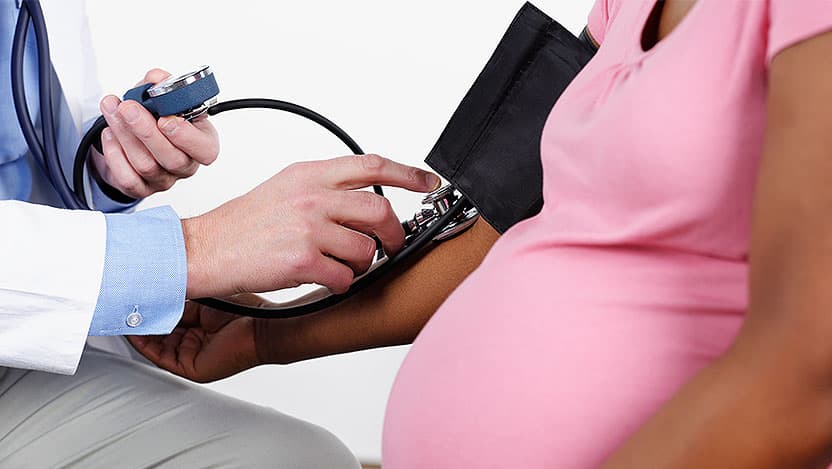Using biomarkers to identify pregnant patients with small babies who are at risk for preeclampsia

Doctors intent on protecting pregnant women from developing preeclampsia face a frustrating reality: There is still no early method of detecting this dangerous type of high blood pressure that develops during pregnancy. As a result, the likelihood that a mother and her baby will experience serious side effects from preeclampsia, including delivering early, increase.
Clinical diagnosis of preeclampsia is so inaccurate that the features we look for, such as high blood pressure and protein in the urine, only predict preeclampsia 20% of the time. MPHresearch in the American Journal of Obstetrics & Gynecology Maternal-Fetal Medicine uses biomarkers to look at potential links between preeclampsia and intrauterine growth restriction (IUGR), a condition in which babies do not grow to normal size.
If a fetus is unusually small, there are many possible causes. Sometimes, babies are just naturally small. Sometimes it’s caused by factors such as infections and genetic or placenta abnormalities. But scientists know that mothers of babies who are small are more likely to develop preeclampsia – and it remains difficult to pinpoint who is most in danger using traditional clinical tests.
The team followed 45 women who were pregnant with smaller babies and found that those who had a high ratio of soluble fms-like tyrosine kinase-1 to placental growth factor – two proteins associated with preeclampsia – were at increased risk not only for developing preeclampsia within two weeks and for preterm delivery, but also for having a baby with a lower birth weight.
Although limited by the study’s size, the researchers believe patients with fetal growth restriction could benefit from being divided into low- and high-risk groups during their pregnancies to provide better care for those most likely to develop preeclampsia. The pregnancy complication can develop before or after delivery.
"We're continuing to understand and define the process better, and one day we hope to have sufficient biomarkers and clinical symptoms that can be used to create an algorithm for early detection," said KT Jerry Yeo, PhD, the director of clinical chemistry who validated the tests used to measure the biomarkers.
UChicago Medicine had been studying the role of these biomarkers to risk stratify women for preeclampsia for several years. Although use of the biomarkers is approved in Europe and Asia, a prognostic test has yet to be approved in the United States.
This study is unique in that a majority of the participants self-identified as Black or African American. (Most preeclampsia biomarkers studies have focused on Caucasian women.)
“I think this adds an important piece to addressing the disparities in research that exist to ensure that when these tests become available in the United States, they’re fair and equitable for the different patient populations we apply them to and take care of,” said study first author Gabriel Arenas, MD, a fourth-year resident in obstetrics and gynecology.
I can’t wait for a day when I see a woman in my clinic or in labor or delivery and I can give her an accurate assessment for her risk of developing preeclampsia. That will be life-changing in these situations.
The team is working on additional preeclampsia biomarker studies, including testing biomarkers in patients with clinical suspicion of preeclampsia to better predict outcomes and in-person interviews with patients for their perspectives on being tested for preeclampsia. The group is also conducting clinical trials for treatments to reduce the long-term complications of preeclampsia.
These biomarkers have the potential to personalize medicine and provide patient- and pregnancy-specific risk. It will be life-changing for our team to be able to see a woman in UChicago Medicine clinic or in labor or delivery and give her an accurate assessment for her risk of developing preeclampsia.
Our team's effort to understand and treat preeclampsia were acknowledged with a one-year High Priority, Short-Term Project Award from National Heart, Lung, and Blood Institute (NHLBI), to support her investigation of novel therapeutics for preeclampsia.
The investigator-initiated study, “Use of the angiogenic biomarker profile to risk stratify patients with fetal growth restriction,” was funded by Roche Diagnostics Corporation. Roche played no part in the study design, analysis or article preparation. Additional authors include Nga Y. Tang, Joana Lopes Perdigao, Harjot Kaur, Jacques S. Abramowicz and Kathryn Mussatt of the University of Chicago Medicine and Ariel Mueller of Massachusetts General Hospital and Harvard Medical School. Sarosh Rana is a consultant to Roche Diagnostics Corporation and Thermo Fisher Scientific and has funding from Roche Diagnostics Corporation and Siemens for studies on angiogenic factors in pregnancy. Ariel Mueller reports serving as a statistical consultant to Roche Diagnostics Corporation.
